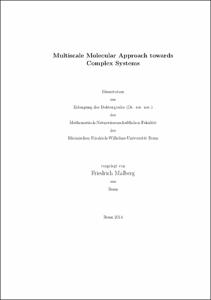Malberg, Friedrich: Multiscale Molecular Approach towards Complex Systems. - Bonn, 2014. - Dissertation, Rheinische Friedrich-Wilhelms-Universität Bonn.
Online-Ausgabe in bonndoc: https://nbn-resolving.org/urn:nbn:de:hbz:5n-36967
Online-Ausgabe in bonndoc: https://nbn-resolving.org/urn:nbn:de:hbz:5n-36967
@phdthesis{handle:20.500.11811/6139,
urn: https://nbn-resolving.org/urn:nbn:de:hbz:5n-36967,
author = {{Friedrich Malberg}},
title = {Multiscale Molecular Approach towards Complex Systems},
school = {Rheinische Friedrich-Wilhelms-Universität Bonn},
year = 2014,
month = jul,
note = {This thesis reports on multiscalar studies of two different complex systems, namely ionic liquids and the supramolecular structures rotaxanes. To obtain insights into the complex interactions present in these systems, static quantum chemical calculations, ab initio molecular dynamics and classical molecular dynamics simulations were carried out, considering the most sophisticated methods and force fields, which are applicable. The primary goal was to develop a multiscale approach, using a combined set of methods adapted to the characteristic size and time scale of the studied systems, to describe how the complex interactions present influence the physicochemical properties, with a special focus on interactions like hydrogen bonding and dispersion interactions.
For ionic liquids, the formation of ion pairs and the evaporation were the objects of this research. Dynamical probing of the interactions by means of ab initio molecular dynamics simulations pointed to a temperature-dependent structural rearrangement of the interactions in the transition from the bulk to the gas phase. With the aid of classical molecular dynamics simulations, applying the same force field, which was shown to be able to reproduce the molecular structure and to describe the surface of ionic liquids properly, a qualitative picture of the formation of an ion pair at the surface as well as of its departure into the vacuum was gained. From this qualitative picture, a multistep evaporation mechanism is proposed. Furthermore, the effect of charge transfer on the formation of ion pairs in ionic liquids has been probed using different population analysis techniques, indicating that the ion pairing in the bulk phase of ionic liquids seems to be less important than thought before.
The object of the rotaxane research was to understand the complexity of their binding patterns. Static quantum chemical calculations were conducted to probe substitution and flexibility effects of the axle in these host-guest complexes. In agreement with experimental data, it was shown that substitution on the diamid axle of Vögtle-type rotaxanes changes the binding properties in several ways and that depending on the substituent the binding is driven either by enthalpic or entropic effects. Increasing the flexibility of the axle increases the binding energy of Leigh-type rotaxanes independent of the substitution of the axle. Stoppers on the axle, which are attributed a minor role in the binding of rotaxanes, showed an influence on intramolecular interactions, as the trend of hydrogen bonding symmetry observed for different flexibility of axles is reversed in their presence. Including solvent effects through an implicit solvent model, weakens the complex binding for all systems, as the different parts of the host-guest complexes are differently stabilized.},
url = {https://hdl.handle.net/20.500.11811/6139}
}
urn: https://nbn-resolving.org/urn:nbn:de:hbz:5n-36967,
author = {{Friedrich Malberg}},
title = {Multiscale Molecular Approach towards Complex Systems},
school = {Rheinische Friedrich-Wilhelms-Universität Bonn},
year = 2014,
month = jul,
note = {This thesis reports on multiscalar studies of two different complex systems, namely ionic liquids and the supramolecular structures rotaxanes. To obtain insights into the complex interactions present in these systems, static quantum chemical calculations, ab initio molecular dynamics and classical molecular dynamics simulations were carried out, considering the most sophisticated methods and force fields, which are applicable. The primary goal was to develop a multiscale approach, using a combined set of methods adapted to the characteristic size and time scale of the studied systems, to describe how the complex interactions present influence the physicochemical properties, with a special focus on interactions like hydrogen bonding and dispersion interactions.
For ionic liquids, the formation of ion pairs and the evaporation were the objects of this research. Dynamical probing of the interactions by means of ab initio molecular dynamics simulations pointed to a temperature-dependent structural rearrangement of the interactions in the transition from the bulk to the gas phase. With the aid of classical molecular dynamics simulations, applying the same force field, which was shown to be able to reproduce the molecular structure and to describe the surface of ionic liquids properly, a qualitative picture of the formation of an ion pair at the surface as well as of its departure into the vacuum was gained. From this qualitative picture, a multistep evaporation mechanism is proposed. Furthermore, the effect of charge transfer on the formation of ion pairs in ionic liquids has been probed using different population analysis techniques, indicating that the ion pairing in the bulk phase of ionic liquids seems to be less important than thought before.
The object of the rotaxane research was to understand the complexity of their binding patterns. Static quantum chemical calculations were conducted to probe substitution and flexibility effects of the axle in these host-guest complexes. In agreement with experimental data, it was shown that substitution on the diamid axle of Vögtle-type rotaxanes changes the binding properties in several ways and that depending on the substituent the binding is driven either by enthalpic or entropic effects. Increasing the flexibility of the axle increases the binding energy of Leigh-type rotaxanes independent of the substitution of the axle. Stoppers on the axle, which are attributed a minor role in the binding of rotaxanes, showed an influence on intramolecular interactions, as the trend of hydrogen bonding symmetry observed for different flexibility of axles is reversed in their presence. Including solvent effects through an implicit solvent model, weakens the complex binding for all systems, as the different parts of the host-guest complexes are differently stabilized.},
url = {https://hdl.handle.net/20.500.11811/6139}
}






